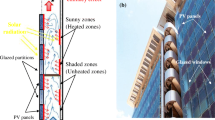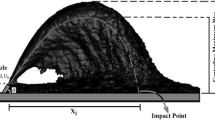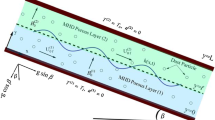Abstract
In this article, Particle Image Velocimetry (PIV) experiments are carried out in an attempt to predict the morphology of fluid flow induced by natural convection in an Inclined PhotoVoltaic Double Skin Façade (IPVDSF) during transient and laminar regimes. These experiments were performed on an unevenly heated channel with an aspect ratio Ar = 5.2 and heated with UHF equal to 445 W/m2, corresponding to a modified Rayleigh number Ram = 2.2 106. It should be noted that the study is carried out under both realistic geometrical and environmental conditions. Seeking to simulate the impact of the surroundings, the unevenly heated channel is immersed within a water reservoir. Besides the investigations on fluid flow behavior, the purpose of this work is to plug the gap between baseline data to be used for numerical findings accuracy and the data helping in design development of such systems, while keeping in mind aesthetics as well as PhotoVoltaic (PV) efficiency enhancement aspects. The considered dispositions of the PVDSF duct are a negative slope (-10°) and positive slope (+ 10°), compared with the baseline case of vertical slope 0°. Results are described by streamlines and velocity field. The main observation is a complicated topological flow morphology within the PVDSF channel, but it should also be noted that the slope has a significant effect on flow and velocity fields for both flow regimes. Excellent agreement is finally found between the current experimental results and the theoretical ones.











Similar content being viewed by others
Abbreviations
- H:
-
Height of the heated area, m
- d:
-
Inter-wall distance, m
- Cp :
-
Specific heat capacity, J/kg.K
- g:
-
Acceleration due to Earth’s gravity, m/s2
- Pr:
-
Prandtl number (= ν/α)
- Ra:
-
Rayleigh number (= (gβϕd4)/(λν2) Pr)
- Ram:
-
Modified Rayleigh number (= Ra/Ar)
- Ar:
-
Channel aspect ratio (= H/d)
- Vp:
-
Precipitation velocity, m/s
- V:
-
Y velocity component, m/s
- x,z:
-
Vertical and horizontal coordinates, m
- β:
-
Volume expansion coefficient, 1/K
- δ:
-
Thermal to dynamical layer thickness ratio (δ = 0.653 for Pr = 7)
- ϕ:
-
Uniform surface heat flux, W/m2
- λ:
-
Thermal conductivity, W/m.K
- ɵ:
-
Temperature, K
- ρ:
-
Fluid mass density, kg/m3
- v:
-
Kinematic viscosity, m2/s
- μ:
-
Absolute viscosity, Pa.s
- Α:
-
Thermal diffusivity, m2/s
- ω:
-
DSF channel slope, °
- W:
-
Wall
- ∞:
-
Ambient
- 0:
-
Reference value
References
Hamed TA, Alshare A, El-Khalil H (2019) Passive cooling of building-integrated photovoltaics in desert conditions: Experiment and modeling. Energy 170:131–138. https://doi.org/10.1016/j.energy.2018.12.153
Radziemska E (2003) The effect of temperature on the power drop in crystalline silicon solar cells. Renew Energy 28:1–12. https://doi.org/10.1016/S0960-1481(02)00015-0
Ma T, Yang H, Zhang Y, Lu L, Wang X (2015) Using phase change materials in photovoltaic systems for thermal regulation and electrical efficiency improvement: a review and outlook. Renewable Sustainable Energy Rev 43:1273–1284. https://doi.org/10.1016/j.rser.2014.12.003
Skoplaki EE, Palyvos JA (2009) On the temperature dependence of photovoltaic module electrical performance: a review of efficiency/power correlations. Sol Energy 83:614–624. https://doi.org/10.1016/j.solener.2008.10.008
Abergel T, Delmastro C (2020) Tracking-buildings-2020. https://www.iea.org/reports/tracking-buildings-2020
Brinkworth BJ, Cross BM, Marshall RH, Yang H (1997) Thermal regulation of photovoltaic cladding. Sol Energy 61:169–178. https://doi.org/10.1016/S0038-092X(97)00044-3
Zogou O, Stapountzis H (2012) Flow and heat transfer inside a PV/T collector for building application. Appl Energy 91:103–115. https://doi.org/10.1016/j.apenergy.2011.09.019
Assoa YB, Gaillard L, Ménézo C, Negri N, Sauzedde F (2018) Dynamic prediction of a building integrated photovoltaic system thermal behaviour. Appl Energy 214:73–82. https://doi.org/10.1016/j.apenergy.2018.01.078
Nižetić S, Grubišić-Čabo F, Marinić-Kragić I, Papadopoulos AM (2016) Experimental and numerical investigation of a backside convective cooling mechanism on photovoltaic panels. Energy 111:211–225. https://doi.org/10.1016/j.energy.2016.05.103
Mittelman G, Alshare A, Davidson JH (2009) A model and heat transfer correlation for rooftop integrated photovoltaics with a passive air-cooling channel. Sol Energy 83:1150–1160. https://doi.org/10.1016/j.solener.2009.01.015
Goossens D, Goverde H, Catthoor F (2018) Effect of wind on temperature patterns, electrical characteristics, and performance of building-integrated and building-applied inclined photovoltaic modules. Sol Energy 170:64–75. https://doi.org/10.1016/j.solener.2018.05.043
Yongqiang L, Ling Z, Zhongbing L, Lei X, Xiliang W, Jing W (2018) Experimental study and performance evaluation of a PV-blind embedded double skin façade in winter season. Energy 165(B):326–342. https://doi.org/10.1016/j.energy.2018.09.175
Ahmed Hamza H, Ahmed M, Abdel-Gaied SM (2013) Investigation of heat transfer and fluid flow in transitional regime inside a channel with staggered plates heated by radiation for PV/T system. Energy 59:255–264. https://doi.org/10.1016/j.energy.2013.06.047
Athienitis AK, Barone G, Buonomano A, Palombo A (2018) Assessing active and passive effects of façade building integrated photovoltaics/thermal systems: dynamic modelling and simulation. Appl Energy 209:355–382. https://doi.org/10.1016/j.apenergy.2017.09.039
Zhang T, Yang H (2019) Flow and heat transfer characteristics of natural convection in vertical air channels of double-skin solar façades. Appl Energy 242:107–120. https://doi.org/10.1016/j.apenergy.2019.03.072
Wang Y, Tian W, Ren J, Zhu L, Wang Q (2006) Influence of a building’s integrated-photovoltaics on heating and cooling loads. Appl Energy 83(9):989–1003. https://doi.org/10.1016/j.apenergy.2005.10.002
Agrawal B, Tiwari G (2010) Optimizing the energy and exergy of building integrated photovoltaic thermal (BIPVT) systems under cold climatic conditions. Appl Energ 87(2):417–426. https://doi.org/10.1016/j.apenergy.2009.06.011
Candanedo LM, Andreas A, Kwang-Wook P (2011) Convective heat transfer coefficients in a building-integrated photovoltaic/thermal system. J Sol Energy Eng 133(2):021002. https://doi.org/10.1115/1.4003145
Cherif Y, Sassine E, Lassue S, Zalewski L (2020) Experimental and numerical natural convection in an asymmetrically heated double vertical façade. Int J Therm Sci 152:106288. https://doi.org/10.1016/j.ijthermalsci.2020.106288
Koung Moon K, Dong Ho N, Gyu Hyeon S, Dong-Wook J, Ho Seon A (2020) Experimental study of turbulent air natural convection in open-ended vertical parallel plates under asymmetric heating conditions. Int J Heat Mass Tranfer 159:120135. https://doi.org/10.1016/j.ijheatmasstransfer.2020.120135
Assunta A, Bernardo B, Furio C, Oronzio M (2020) Transient air natural convection in asymmetrically heated vertical channels. Int Commun Heat Mass Transfer 116:104697. https://doi.org/10.1016/j.icheatmasstransfer.2020.104697
Astarita T, Cardone G (2003) Convective heat transfer in a square channel with angled ribs on two opposite walls. Exp Fluids 34:625–634. https://doi.org/10.1007/s00348-003-0605-1
Hemmer C, Abidi-Saad A, Popa C, Polidori G (2017) Early development of unsteady convective laminar flow in an inclined channel using CFD: application to PV panels. Sol Energy 146:221–229. https://doi.org/10.1016/j.solener.2017.02.050
Fatnassi S, Maad RB, Abidi-Saad A, Polidori G (2017) On the appearance of natural convection induced reversed flow: Precocious hydrodynamic experimental study; Application to PV-DSF systems. Appl Therm Eng 127:1598–1607. https://doi.org/10.1016/j.applthermaleng.2017.09.093
Fatnassi S, Abidi-Saad A, Ben Maad R, Polidori G (2018) Numerical study of spacing and alternation effects of parietal heat sources on natural convection flow in a DSF-channel: application to BIPV. Heat Mass Transfer 54:3617–3629. https://doi.org/10.1007/s00231-018-2378-3
Abidi-Saad A, Polidori G, Kadja M, Beaumont F, Popa C, Korichi A (2016) Experimental investigation of natural convection in a vertical rib-roughened channel with asymmetric heating. Mech Res Commun 76:1–10. https://doi.org/10.1016/j.mechrescom.2016.06.001
Abidi-Saad A, Kadja M, Popa C, Polidori G (2017) Effect of adiabatic square ribs on natural convection in an asymmetrically heated channel. Heat Mass Transfer 53:743–752. https://doi.org/10.1007/s00231-016-1853-y
Mallick TK, Eames PC, Norton B (2007) Using air flow to alleviate temperature elevation in solar cells within asymmetric compound parabolic concentrators. Sol Energy 81:173–184. https://doi.org/10.1016/j.solener.2006.04.003
Daghigh R, Ruslan MH, Sopian K (2011) Advances in liquid based photovoltaic/thermal (PV/T) collectors. Renewable Sustainable Energy Rev 15(8):4156–4170. https://doi.org/10.1016/j.rser.2011.07.028
Popa C, Ospir D, Fohanno S, Chereches C (2012) Numerical Simulation of Dynamics Aspects of Natural Convection Flow in a Double-skin Façade. Energy Build 50:229–233. https://doi.org/10.1016/j.enbuild.2012.03.042
Beaumont F, Liger-Belair G, Polidori G (2015) Flow analysis from PIV in engraved champagne tasting glasses: flute versus coupe. Exp Fluids 56:170. https://doi.org/10.1007/s00348-015-2040-5
Beaumont F, Liger-Belair G, Bailly Y, Polidori G (2016) A synchronized particle image velocimetry and infrared thermography technique applied to convective mass transfer in champagne glasses. Exp Fluids 57:85. https://doi.org/10.1007/s00348-016-2180-2
Polidori G, Mladin EC, Lorenzo T (2000) Extension de la méthode de Karman-Pohlhausen aux régimes transitoires de convection libre, pour Pr > 0,6. CR Acad Sci, Ser IIb : Mech 328(10):763–766. https://doi.org/10.1016/S1620-7742(00)01251-4
Amini N, Hassan YA (2009) Measurements of jet flows impinging into a channel containing a rod bundle using dynamic PIV. Int J Heat Mass Tranfer 52:5479–5495. https://doi.org/10.1016/j.ijheatmasstransfer.2009.07.002
Doligalski TL, Smith CR, Walker JDA (1994) Vortex interactions with walls. Ann Rev Fluid Mech 26:573–616. https://doi.org/10.1146/annurev.fl.26.010194.003041
Ospir D, Popa C, Chereches C, Polidori G, Fohanno S (2012) Flow visualization of natural convection in a vertical channel with asymmetric heating. Int Commun Heat Mass Transfer 39:486–493. https://doi.org/10.1016/j.icheatmasstransfer.2012.02.005
Author information
Authors and Affiliations
Corresponding author
Ethics declarations
Conflict of interest
On behalf of all authors, the corresponding author declares no conflict of interest.
Additional information
Publisher's Note
Springer Nature remains neutral with regard to jurisdictional claims in published maps and institutional affiliations.
Rights and permissions
About this article
Cite this article
Fatnassi, S., Abidi-Saad, A., Bouraoui, M. et al. Experimental free convection-induced flow inside an unevenly heated inclined duct in the transient and laminar regimes; application to PV-DSF installations. Heat Mass Transfer 58, 2161–2174 (2022). https://doi.org/10.1007/s00231-022-03237-8
Received:
Accepted:
Published:
Issue Date:
DOI: https://doi.org/10.1007/s00231-022-03237-8




